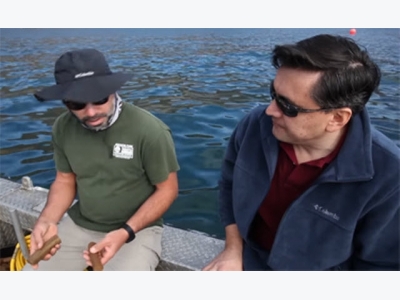New soy-based feed developed for bluefin tuna aquaculture

A new soy-based aquafeed being developed for farm-raised bluefin tuna has been successfully tested in a project led by the Illinois Soybean Association and Ichthus Unlimited.
The results of the trail were presented by Ichthus Unlimited’s by Alejandro Buentello at the Offshore Mariculture Conference in Ensenada, Mexico last month.
“The successful research results should help provide permanence to tuna aquaculture, and can become the platform upon which commercially manufactured tuna feeds can now be developed,” said Buentello. “Closed-cycle cultivation of tuna aquaculture, from hatch to harvest, combined with sustainable formulated grow-out diets, offer the best opportunity we have to prevent the depletion of wild tuna stocks while supplying the global market demand for these species.”
The research tested several soy-based feeds with larval Atlantic bluefin tuna in Spain and with juvenile yellowfin tuna in land-based facilities in Panama. Following the initial round of testing, a new aquafeed formula was developed that found success in a second round of trails with ranched Pacific bluefin tuna in ocean net pens off the northwest coast of Mexico. The new feed had 10 times less fishmeal and fish oil than typical feed used for farmed bluefin tuna and lowered the tunas’ feed-conversion ratio to 4:1.
The Illinois Soybean Association funded the research, while a number of companies, including Archer Daniels Midland, Tyson, Omega Protein, Midwest Ag Enterprises, Krill Canada, and APC and Originates contributed raw materials to the project, while ADM contributed use of its blending facilities and other resources.
Mark Albertson of the Illinois Soybean Association said the new feed is a technological breakthrough that will help increase the sustainability of tuna farming, which typically requires a large amount of baitfish, such as sardines or anchovies, that are used in feeds.
“This feed breakthrough is a significant step towards closed cycle cultivation of tuna species, which will ease pressure on threatened wild tuna populations,” Albertson said. “We are eager to see this work continue to both uncouple tuna ranching from the dependence on wild-caught baitfish, and open the door for truly sustainable hatch-to-harvest tuna farming.”
Another innovative aspect of the feed is that it floats, allowing it to be better monitored and retrieved if uneaten. Furthermore, the feed is nutritionally dense, requiring less volume, and is projected to be almost twice as economical as baitfish.
“The new diet is also significantly better for the environment, as the floating feed,” Albertson said. “[And] the diet is avidly consumed by the tuna and made from sustainable, renewable ingredients.”
In order to document the project, the Illinois Soybean Association produced a video summarizing the research project and its potential impact on protecting endangered wild tuna stocks.
Có thể bạn quan tâm
 Salmon farmers limiting time at sea for biological risk mitigation
Salmon farmers limiting time at sea for biological risk mitigation Recirculating aquaculture systems (RAS) built on land are gaining in popularity, with a slew of modern indoor facilities popping up recently in Poland
 Biosecurity practices on fish farms need beefing up
Biosecurity practices on fish farms need beefing up Why does biosecurity matter? The aquaculture industry is expanding at a rapid pace due to intensive farming strategies and research improvements from the fields
 Extensive wrasse use keys up ‘cleaner fish’ conservation questions
Extensive wrasse use keys up ‘cleaner fish’ conservation questions If there were a prize for the most unusual exhibit at this year’s Seafood Expo Global in Brussels, it might have gone to Wester Ross Salmon in the Scottish